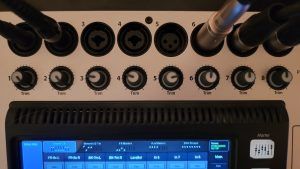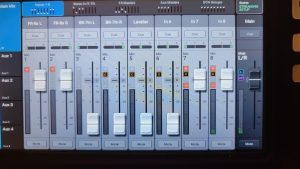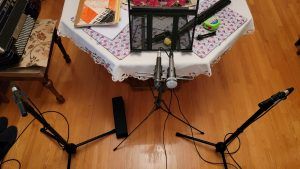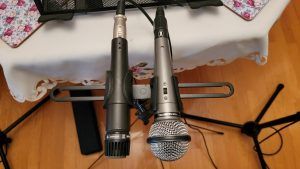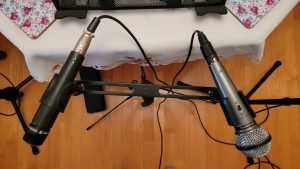December 23, 2024
In an attempt to show a couple differences between dynamic and condenser mics and mic distances for condensers, I decided to do a quick little test.
The participants:
All recordings will be saved to an SSD drive attached to my QSC TouchMix 8 mixer. The mics involved are quite basic:
- a pair of Neewer NW-410 condensers to represent the affordable mid-range mics ($100US for a matched pair with 3 different heads, cardioid, super-cardioid and omni)
- an old but “like new” Radio Shack clone of an SM58 dynamic mic (about $100 brand new but they are no longer available. Today on eBay they go anywhere from $10US to $50US. Real SM58s are about $100US)
- an original Shure SM-57 dynamic mic ($100US for each)
The bargain of the day are the Neewer NW-410 condenser mics, with 2 mics and 3 polar patterns (cardioid, super-cardioid and omni) all for the same approximate cost of a single SM57 or SM58.
Dynamic mics are far from sensitive, so I basically had to set the gain levels on the mixer to 100% and even then had to do some major boosting of the levels in post (had to add 15db digital boost!). The condensers are a lot more sensitive and with zero digital boost, the gain levels were WAY LOWER, set to 50% with the mics at 45″ away and I had to drop the gain an additional 10db when the condensers were 15″ away, and even then, it was a touch too loud.
Speaking about distances, I did play with mic distances for the condenser mics, and the 2 distances tested were approximately 45″ and a closer setup at about 15″. In both of these cases the mics were a tape measured distance of 40″ apart for a good strong stereo separation of left and right hands. In post it is easy to reduce stereo distance, harder to create a stereo image if the channels pollute each other.
A final 2 tests were where I used the stereo bar with the 2 dynamic mics both very closer (side by side for a mono sound) and at opposite ends on the stereo bar at 12″ apart and pointed away from each other to get a bit of a stereo image going. The separation was a little more than I expected, so thats a positive.
First, let’s look at the settings used on the mixer. I set up channel 1 for the SM57 and channel 2 for the SM58 clone (the 2 dynamic mics). Channels 7-8 were for the pair of NW-410 condenser mics.
Looking at the gain knobs of the mixer we can see the dynamic mics were gained to 100% and the condensers were at 50% (channels 3-4-5 were not used and channel 6 is set at 50% for the wireless lavalier mic, which I ended up not using anyway):
The faders were all set to unity:
At these levels we hit -20 on the dynamic mics and -10db on the condenser mics (important note: This was when the condenser mics were at the 45″ distance, the dynamic mics were set with the gain to maximum AND an added 15db of gain was added in post!). With the gain on the condenser mics set to 50% and moved from 45″ to 15″, the condenser mics pushed us in to big time clipping so I had to drop the gain by 20db to get it down to the -10 range on the meters. At these distances with the dynamic mics, the sound would be unusable and near inaudible in the recording.
Basically, moving the dynamic mics further back means that you need to boost preamp gain levels at least a further 20db and if too far back you max them out and introduce noise or are stuck with very low recording levels that if you try to boost in post, increases local sounds and noise levels, and the audio quality of course, also drops.
In this case, having a recording device that has high (75db or more), gain levels is important… but maxed out gain levels are never as clean as when closer and when gain levels are lower. Also, though it is not sound related, when recording with dynamic mics, they will appear firmly in the video that you are recording… something that you can avoid when using condensers as they can be placed a bit further away.
So, does that mean that dynamic mics are not good choices for recording accordion? Yes and no. Dynamic mics offer a fair sound and are generally lower priced, but they have some serious limitations. They are very gain hungry and small back and forth movements from the mics can cause drops in volume levels that are noticeable, especially when recording (try speaking in to a dynamic mic at 2″ and then move to 12 inches… huge difference!).
Condenser mics are affected much less by increased distance, however we still want to keep them close to reduce the entrance of the ambient sounds, but distances at around 20-25 inches in a reverberant room will get you most of the sound quality… 15″ will get you even more quality and a lot more volume, so you will have to turn down the gain on the mixers even further and receive nothing but improved audio.
Distance is not a big thing if all you are doing is recording audio, but if you make a video and want the quality audio that these mics offer, they will be seen. Honestly, the visibly intrusive presence of the mics is a PITA to deal with.
The Tests!
OK, so, basically we are going to be doing 2 recordings with 2 mic setups each time:
- Hearing just the camera mic (ick! A good reminder of why I hate that quality level)
- Condenser mics at 45 inches away and Dynamic mics at 12″ away both pointing straight ahead.
- Condenser mics at 15 inches away and Dynamic mics at 12″ away but pointing left and right on a stereo bar
So in essence we get to hear 6 tests in 2 recordings:
- The camera mic
- mono SM57
- mono SM58
- SM57 and SM58 in a stereo config, 12 inches apart and pointed in different directions
- condensers in stereo setup, 45″ away
- condensers in stereo setup, 15″ away
The Results!
Well, I had a good idea of what the results would be, but what surprised me was the nuances of sound differences between all 3 mics.
- The camera mic sounded horrible, as expected in a reverberant room. An excellent reminder of why I never use that method of capturing audio!
- The SM57 sounded good… until you heard it against the SM58 or the condensers, then it sounded very harsh and tinny.
- The SM58 clone sounded better… just way under-volumed and required a TON of gain in post to get to decent levels. The mixer was maxed out at 60db of output and an additional 15db of digital gain was needed to make the audio usable.
- The NW-410 condensers were surprising at how loud they were at 45″ away, NO digital gain and the trims were set to 50%, but I did expect them to need to be turned down more when only 15″ away.
The most natural and most pleasant sound for my ears was the NW-410 condensers, between their more neutral sound and much lower gain levels, this made them a zero effort proposition to get decent sound from.
In comparison, my SE Electronics SE4400a condensers sound much cleaner and even more natural, and with that SLIGHT boost in the upper range make the sound more vibrant and easier to accept whatever EQ I may want to add. Those high-end condenser mics are also near 5 times more expensive!
What did I learn? If all you want to do is record your accordion, you can use about any mic you want and get some kind of sound… but dynamic mics give a better quality. That said, even higher up the quality level are the condensers and those are the ones that you want… but not any condensers, so stay away from the $20 condensers that will turn your lovely accordion in to sounding like a tin can!
